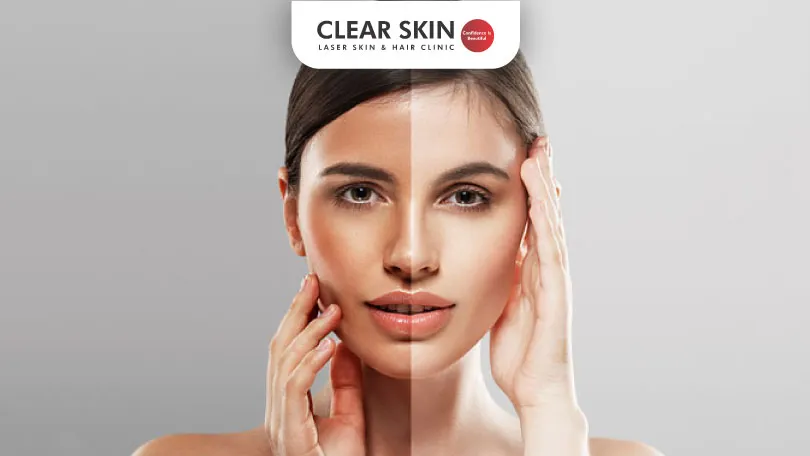Skin Tan Removal Treatment: Patient testimonials
Reviewed By: Dr Dhananjay chavan
Updated on: 13th December, 2023

Know what our patients are saying about their journey of defeating Skin Tan and Pigmentation with Clearskin
Table Of Content
- Anish’s Skin Tan Removal Journey
- Shikha’s Skin Tan Removal Journey
- Suman’s Skin Tan Removal Journey
- Ankitha’s De-tanning Success Story
- conclusion
Anish’s Skin Tan Removal Journey
I need to travel a lot because of my work as I am a sales person and skincare isn’t possible all the time. In the past few months, this lifestyle has been taking a toll on my skin as there is a noticeable difference between the skin tone of the body parts exposed to the sun like hands, neck and face and the covered body part like the chest.
My friends and colleagues also started pointing this out to me. When I did some research, I realized that prolonged exposure to the sun can cause this, and I also realised that there are treatments available to reverse it. That’s when I decided to go for skin tan removal treatment.
I contacted Clearskin clinic and booked an appointment. It’s been a month that I am regularly consulting the doctor. Today is my last session. I am completely satisfied with the consultation and the result. Doctor and the team did their best to make me feel confident. Within 2 or 3 sessions, there is a visible difference. My skin tone has also gotten brighter than before.
All doctors and staff are really helpful and friendly. They take out time to explain every procedure in great detail and make sure you are comfortable before and after the treatment. Thank you so much to the Clearskin team.
Shikha’s Skin Tan Removal Journey
I am getting married soon and I wanted to look my best on my wedding day. I have a history of acne as well and hence there are small black spots on my cheeks. I wanted to go for a complete de-tanning before the big day to improve the appearance of my skin and make it blemish-free. That’s when one of my friends suggested Clear Skin.
I contacted them over the phone, fixed an appointment and visited the clinic. I started my skin tan removal and acne treatment, and within 3 to 4 weeks, I could see effective results. My friends and family complimented me on my clearer skin tone.
During the treatment session, the staff were very helpful in clearing up all my doubts and concerns, which made me feel so comfortable. Would highly recommend Clearskin to all.
Suman’s Skin Tan Removal Journey
I am Suman, a 26 yrs old girl from Mumbai. I have recently visited Goa for a music festival. Had a great time with friends at the beach almost every day of my stay.
After a week’s stay in Goa, I returned home with a sun tan which made me almost 2 shades darker. I applied yoghurt, lemon, potato & cucumber juice for a few days. To my surprise, none of them worked. I also noticed some rashes on my face & hands. I was too worried about my skin and that’s when I decided to consult a dermatologist.
The doctor told me it was a severe case of sun burn and sun tan. Doctors and staff were very helpful and they suggested proper treatment after analysing the root cause of my problem. The Clear Skin team performed a session of chemical peel to clear off the outer dead skin cells. After that, I maintained a regular skin care routine as suggested by them. Within a few weeks, I was back to my natural skin tone and glow. All thanks to the Clear Skin team.
Ankitha’s De-tanning Success Story
I did my de-tanning therapy at Clearskin Clinic and I am very happy with the results. My skin is a sensitive one but this therapy worked for me. Overall experience is good. Doctor and staff are very co-operative. Their technique and instruments are very advanced. Clearskin Clinic Pune is one of the best skin clinics in Maharashtra. The staff are refreshingly efficient, intelligent, responsive.
I feel this place is perfect if you are looking for a skin solution. Earlier, I tried many treatments but none worked well on me. At Clearskin, the treatments are worth it and the results are fantastic. There’s a huge difference in my skin now and I feel much more confident. Thank you Clearskin.
Do You Know?
Roughly 250 Patients Are Treated
Everyday By These Dermatologists
(You are one click away from flawless skin)
Meet Our Dermatologist!
Conclusion
Prolonged sun exposure can lead to noticeable skin tanning, affecting both appearance and confidence. Stories from individuals like Anish, Shikha, Suman, and Ankitha highlight the successful outcomes of skin tan removal treatments at Clearskin Clinic.
Their advanced techniques and attentive staff have helped many restore their natural skin tone and achieve a radiant glow. Clearskin Clinic offers personalized and effective solutions for various dermatological concerns. For a consultation, contact their experienced dermatologists in Pune at +919584584111 and take the first step towards healthier, brighter skin.
Further Reading
How to Avoid Acne in Monsoons?
Avoid acne in monsoons with a gentle skincare routine, diet tips, and hydration. Get expert advice to manage breakouts and keep your skin clear and healthy.
Does Makeup Cause Acne-Prone Skin?
Worried about breakouts from using makeup? Does makeup cause acne for you? Learn the safe ways to apply makeup for acne-prone skin.
Morning Skin Care Routine for Glowing Skin
Clear Skin Clinic, led by top dermatologists, shares the ideal morning skincare routine to help you achieve a radiant complexion naturally and effectively.
Monsoon Skin Care Tips for Radiant, Healthy Skin
Clear Skin Clinic, led by top dermatologists, shares the ideal morning skincare routine to help you achieve a radiant complexion naturally and effectively.
Have thoughts? Please let us know
We are committed not only to treating you, but also educating you.





